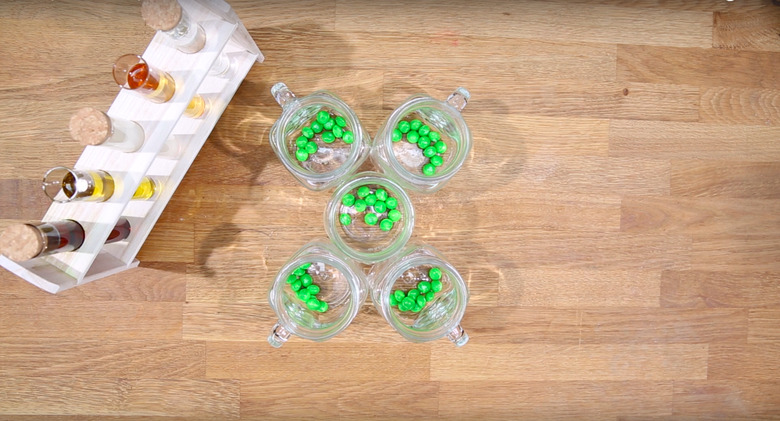Skittles Science Project Ideas
Skittles are more than just a delicious candy. When it comes to school projects, these tiny, colorful treats can serve as the basis for a wide variety of experiments that dazzles both your classmates and teachers.
Dissolving Skittles Science Project
Dissolving
Skittles Science Project
Skittles come in several different colors, which means they all contain different dyes. A science project could break down the differences in those dyes. The project could include figuring out which color Skittle dissolves the fastest when you douse it in solutions such as vinegar or soda. Or, you could test solutions such as milk or water to see whether they dissolve Skittles. These are some potential hypotheses you could answer with a dissolving Skittles project.
1. Organize Skittles and liquids
Gather the different Skittles colors that you want to test into separate piles and then collect the different liquids that might dissolve the Skittles, such as vinegar, milk, bleach, oil, lemon juice and both brown and clear sodas.
2. Pour liquids into each glass
Calculate how long it takes for each liquid to dissolve each Skittle, paying attention to differences like dye colors and liquid temperatures.
This experiment can tell you a lot about how strong liquid solutions and certain dyes are, and it might also earn you some bonus points for color and creativity. As the Skittles dissolve, they leave colorful patterns behind. Try to dissolve them on an object such as a white Styrofoam plate or heavy white poster board, where the colors can stand out and leave behind a rainbow-like display.
Skittles Density Science Project
Skittles
Density Science Project
This experiment explores what happens when different amounts of Skittles dissolve in separate cups of water. The project could determine whether the separate liquids all mix together, or if you can control the density of these liquids to create layers of colors.
1. Separate Skittles by Color
Compile different amounts of each. You're going to be dissolving each color into its own separate liquid, and the goal is to have each color be a slightly different density.
The more Skittles you add, the heavier, and thus denser, the liquid becomes. However, since Skittles all have relatively similar sugar contents (regardless of color) you'll need to drastically vary the number of Skittles per color for the project to work. Alternatively, you can add spoonfuls of sugar to mimic the effects of dissolved Skittles. A tablespoon of sugar contains 12.5 grams of sugar, which equals about four Skittles.
If you want to make a rainbow, make your blue or purple liquid the densest. So, you could put 70 blue Skittles in a clear glass, 50 greens in another, and then 30 yellows, 20 oranges, and 10 reds in their own separate cups. If you don't have that many Skittles, you can use 30 blue, 24 green, 18 yellow, 12 orange and six red, but make sure to stir in tablespoons of sugar to each bowl — 8 (blue), 6 (green), 4 (yellow) and 2 (orange).
2. Dissolve the Skittles
Then, pour a cup of boiling water on top of the Skittles, and wait until the candies completely dissolve in the water.
3. Create the Rainbow
The densest liquid serves as the base. Take the second densest liquid, the one with the second most Skittles in it, and carefully pour that color on top of the base. Make certain to not to do this too quickly. You may want to use a pipette dropper to manage the liquid and guarantee the colors don't mix. Continue the process from the densest to the least dense Skittles.
The result should be a colorful display that demonstrates how density can prevent liquids from mixing.
Skittles Science Project Boards
Skittles
Science Project Boards
A little investigation into what's inside a Skittles bag provides a way to learn about the kinds of questions that researchers turn into hypotheses.
Consider a bag of Skittles and ask questions about it. You could calculate how many yellow Skittles are inside one package, for instance, or determine whether all packages have the same number of red Skittles. The project could also examine people's Skittles-eating habits, figuring out whether people prefer to eat them one by one or by the handful. Or, you could make a chart or graph that tracks which flavor people most prefer.
Then, set out to answer some of these questions by performing the basic research skills needed in any science experiment. To test which color occurs most frequently in Skittles packages, buy several packages, count the number of individual colors and record the data. You can also have family and friends be your research subjects, and observe how they enjoy Skittles or which color is their favorite.
Record all your observations. For a science fair, you can put those observations together as you attempt to answer your hypotheses. A science project board could display your questions, how you set out to answer them and what your research revealed about the typical Skittles package or consumer.
Cite This Article
MLA
Dragani, Rachelle. "Skittles Science Project Ideas" sciencing.com, https://www.sciencing.com/skittles-science-project-ideas-13710545/. 17 May 2019.
APA
Dragani, Rachelle. (2019, May 17). Skittles Science Project Ideas. sciencing.com. Retrieved from https://www.sciencing.com/skittles-science-project-ideas-13710545/
Chicago
Dragani, Rachelle. Skittles Science Project Ideas last modified August 30, 2022. https://www.sciencing.com/skittles-science-project-ideas-13710545/







